A few months ago, if you’d asked me what my biggest vice was, I’d probably tell you that it was sour gummy candy. I love it all — Sour Patch gummi watermelon, Trolli Apple O’s and Sour Crawlers, Haribo Fruit Salad, and more. Whereas most people are fine with just a piece or two, I can eat a whole bag in one sitting and still want more. It’s bad, I know, I know. Don’t tell my mom, lol.
Recently, however, my love for sour gummy candy has been overtaken by my obsession with these tortilla chips from New Seasons, a local Portland supermarket similar to Whole Foods (but pricier and more pretentious, if you can believe that). It makes no sense — in theory, there’s nothing special about these chips. They’re New Seasons’ generic brand, sourced from what looks to be a small shop in Salem, Oregon. All they are are fried white tortilla chips, seasoned with a hint of lime and salt to give them a slightly tart and sweet kick. But they’re so addictive that I’ve banned myself from buying a bag except on special occasions, because I’ve definitely sat down and eaten the entire 1000+ calorie bag in one sitting. Again, don’t tell my mom, lol.
This past Christmas, I bought myself a bag for my stocking and found myself reading the Ingredients list absentmindedly in between binge watching episodes of Black Mirror. Although most of the ingredients were pretty par for the course for what you’d expect for a bag of fancy tortilla chips, there was one that caught my eye: citric acid. The same stuff that gives the sour candy gummies I love so much their tartness too. A quick Google search revealed that citric acid is commonly used for flavor and a preservative in many foods like jams, jellies, sodas, and crunchy savory snacks like crackers and chips.
A light bulb went off in my head; what if I used citric acid in my baking somehow? I’d been trying to develop a solid lemon sugar cookie recipe for a while now, but had been disappointed in my results so far — although the cookies I’d made were perfectly lemony and delicious, they lacked any tart or bite from the lemon and were quickly overwhelmed by all the sugar. I wanted my lemon sugar cookies to have the tartness of lemon curd, with a similar slight pucker that you get from sour candy from the acidity.
It turns out that citric acid is indeed the secret weapon for that bite. After ordering an entirely too big bag from Amazon, I mixed a teaspoon into a small amount of sugar and found that I’d basically created the tart sugar that all my beloved sour candies are coated in. Working backwards from there, I decided to make my standby snickerdoodle recipe (also seen in these raspberry lemon snickerdoodles) and rolled the cookies in the citric acid sugar as opposed to traditional cinnamon sugar mixture. And voila — just like that, it was the lemon sugar cookie I’d been dreaming of for the last few weeks: perfectly lemony and sweet, but with the tang and kick of lemon curd and/or your favorite sour candy. For even more fun, I used Meyer lemons, which I love for their fragrance and sweetness. Enjoy!
-
- You only need a teaspoon of citric acid for this recipe, so I definitely suggest checking the bulk sections of any fancy grocery store, spice shop, or food co-op — I saw some in the bulk spice section at my Whole Foods and, if you live in Portland or the Bay Area, New Seasons. In a pinch, you can buy a giant bag for fairly cheap on Amazon. You can also check the canning section of hardware or general stores — they usually sell citric acid by the canning tools and mason jars as it’s often used to help preserve jams and jellies.
-
- If you don’t want to source citric acid, you can still make these cookies and come out with perfectly wonderful Meyer lemon cookies that aren’t tangy but more traditional — just skip the sugar topping since you won’t need since it’s mostly there to counteract the citric acid and give your cookies pretty yellow specks. Similarly, there’s no need to stick to Meyer lemons for this recipe; you can use regular lemons too.
- A couple other things to note about the ingredients for this recipe: because this is actually based on a snickerdoodle recipe, it uses cream of tartar as a leavener as opposed to baking powder. Cream of tartar is more acidic than baking powder and baking soda, which gives the cookies an added tanginess it wouldn’t otherwise have if I’d used baking powder. It’s worth sourcing the stuff (it’s available at most supermarkets in the herbs section), especially since it pretty much keeps indefinitely in the pantry. I also used six leftover egg yolks I had from another baking project (ehem, this champagne cake), which gave the cookies a signature pale yellow to match their lemon flavor — in a pinch, you can substitute the egg yolks with 2 large eggs and come out with the same results.
Get the Recipe: Tangy Meyer Lemon Sugar Cookies
Ingredients
For the Tangy Sugar Topping
- 1/4 cup (1.75 ounces) granulated sugar
- 1 teaspoon citric acid (see baker's notes for sources)
- fresh zest from 1 medium-small Meyer lemon
For the Meyer Lemon Sugar Cookies
- 1 1/2 cups minus 1 tablespoon (10.20 ounces) granulated sugar
- 1 tablespoon dark brown sugar
- fresh zest from 1 medium-small Meyer lemon
- 2 3/4 cups (12.35 ounces) all-purpose flour
- 2 teaspoons cream of tartar (see baker's notes)
- 1 teaspoon baking soda
- 1 teaspoon kosher salt
- 1 cup (8 ounces) unsalted butter, at room temperature
- 6 large egg yolks (see baker's notes for substitutions)
- 1 teaspoon lemon extract
Instructions
For the Tangy Lemon Sugar Topping
- In a shallow medium bowl, combine 1/4 cup granulated sugar and 1 teaspoon citric acid. Whisk to combine. Add fresh zest from 1 medium-small Meyer lemon and use your fingers to rub the zest into the sugar and citric acid mixture until the sugar smells fragrant and the zest is incorporated throughout the mixture in small clumps. Set aside.
For the Meyer Lemon Sugar Cookies
- Center a rack in the oven and preheat to 350 (F). Prepare two sheet pans by lining with parchment paper sheets and set aside.
- In the bowl of a freestanding electric mixer fitted with a paddle attachment, combine 1 1/2 cups minus 1 tablespoon granulated sugar, 1 tablespoon dark brown sugar, and fresh zest from 1 medium-small Meyer lemon. Whisk to combine and use your fingers to rub the zest into the sugar until the sugar smells fragrant and zest is incorporated throughout the mixture in small clumps. Set aside.
- In a medium bowl, combine 2 3/4 cups all-purpose flour, 2 teaspoons cream of tartar, 1 teaspoon baking soda, and 1 teaspoon kosher salt. Whisk to combine and set aside.
- Return to your mixer bowl and add 1 cup unsalted butter to the sugars and lemon zest from the 2nd step. Beat on medium-high speed for about 2 to 3 minutes, until light and fluffy. Reduce the mixer speed to its slowest setting and add 6 large egg yolks, one at a time, only adding the next egg yolk when the previous one is fully incorporated. Add 1 teaspoon fresh lemon extract. Once incorporated, stop the mixer and use a rubber spatula to scrape down the sides of the bowl. Turn the mixer back on to its lowest setting and gradually add the dry ingredients, beating on low speed until just combined.
- Use a 4-tablespoon cookie dough scoop to measure out cookie dough balls and place them on the lined sheet pans at least 3 inches apart. Right before baking, roll the tops and the sides of each cookie dough ball in the Tangy Lemon Sugar Topping, taking care not to cover the bottom of the cookies — doing so will cause them to stick to the parchment paper. Transfer to the preheated oven and bake for at least 12 minutes, or until the edges are set but the center is slightly puffed and still a little soft. Transfer to a wire rack to cool for 20 minutes on the tray, before using a metal spatula to turn each cookie out onto the rack to cool completely. Repeat with the remaining tray.


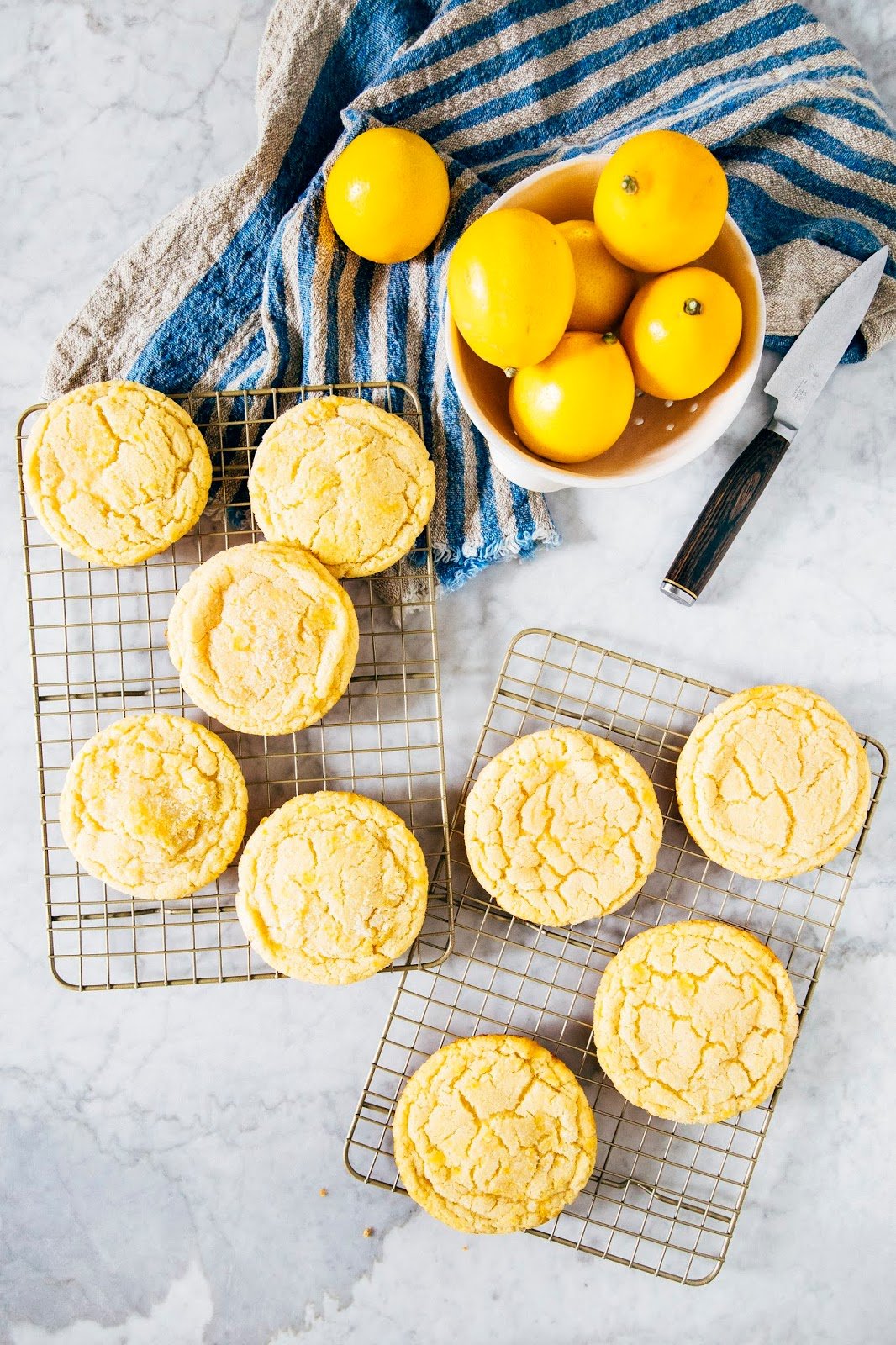
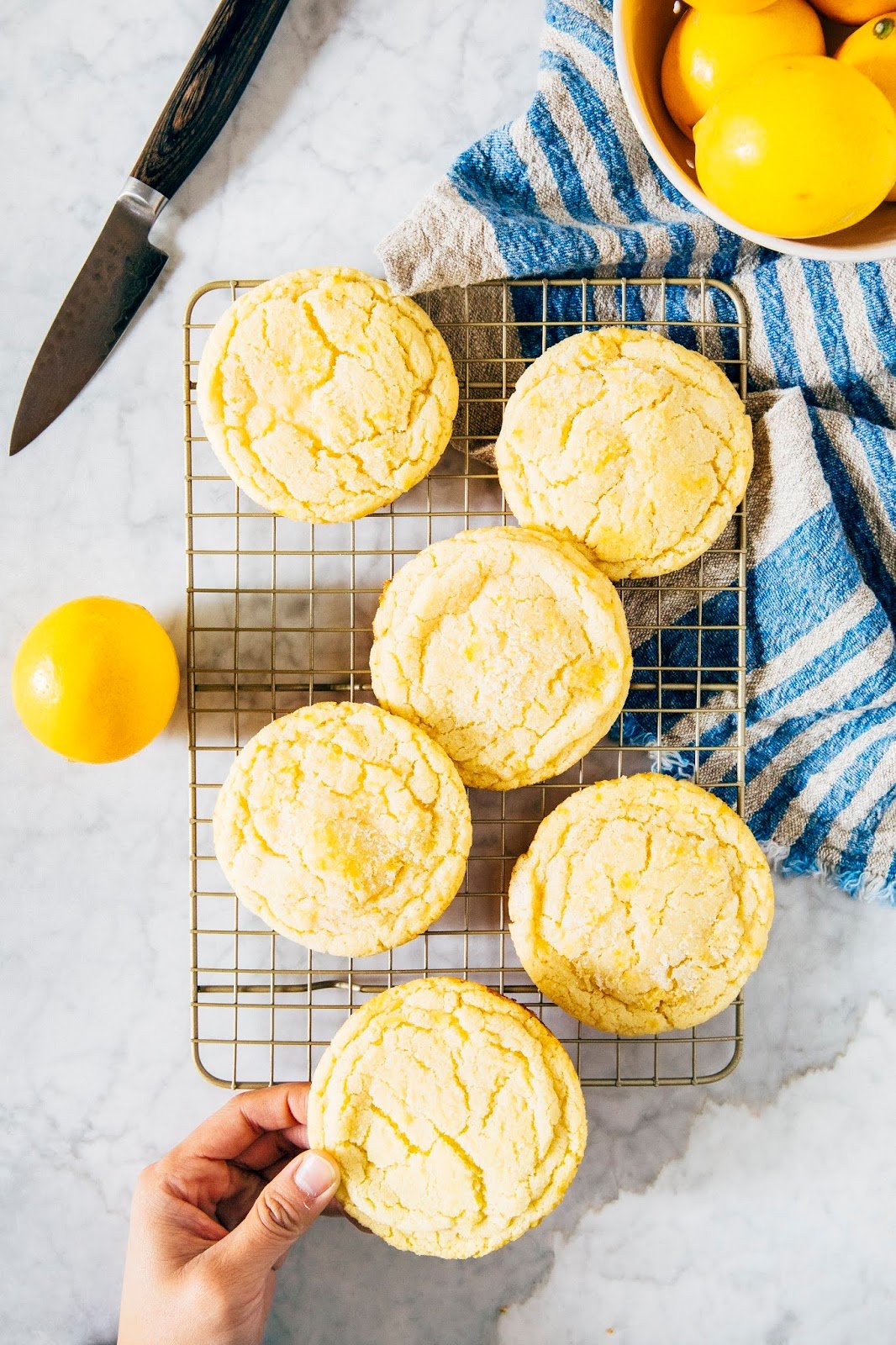
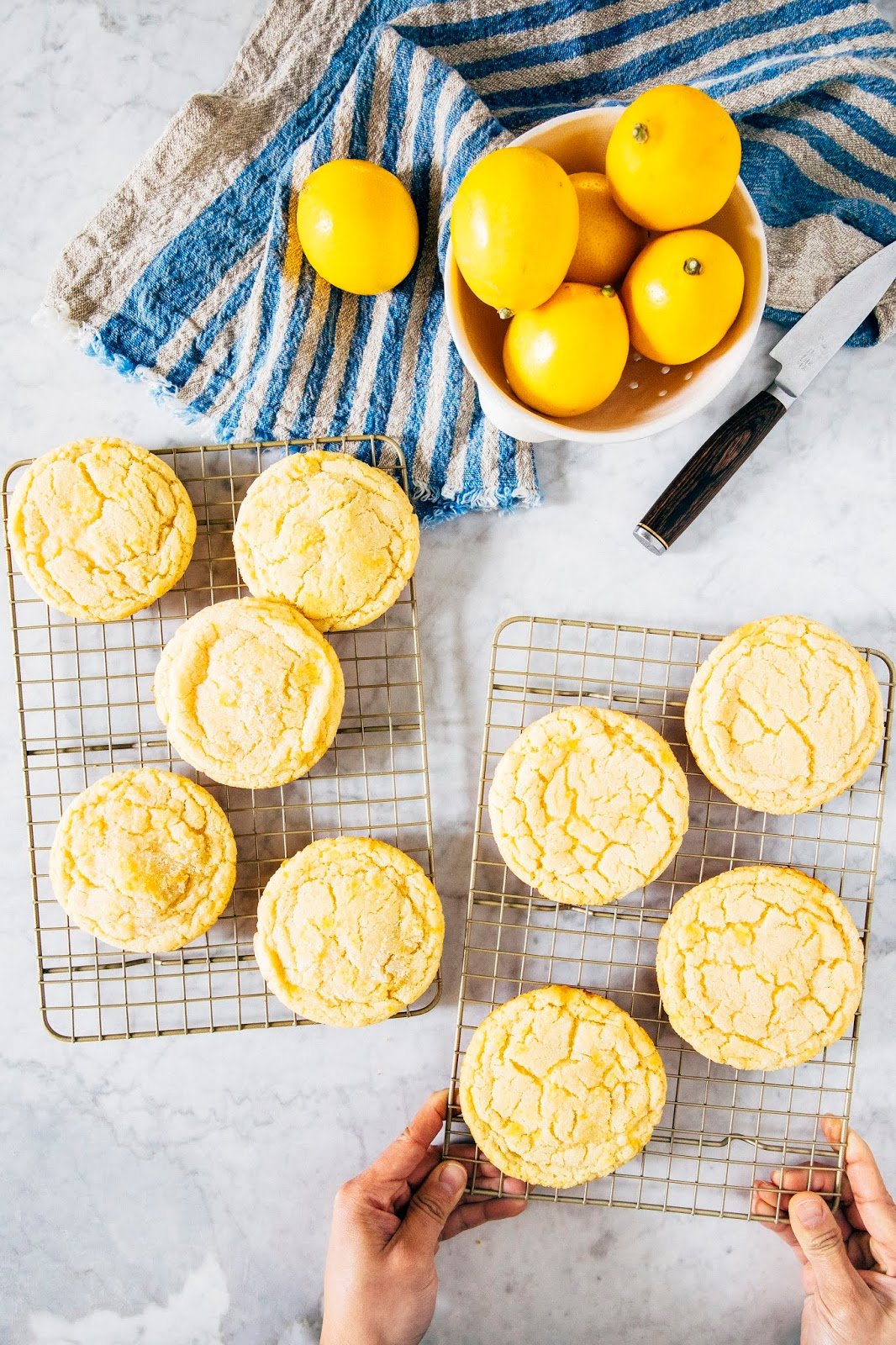
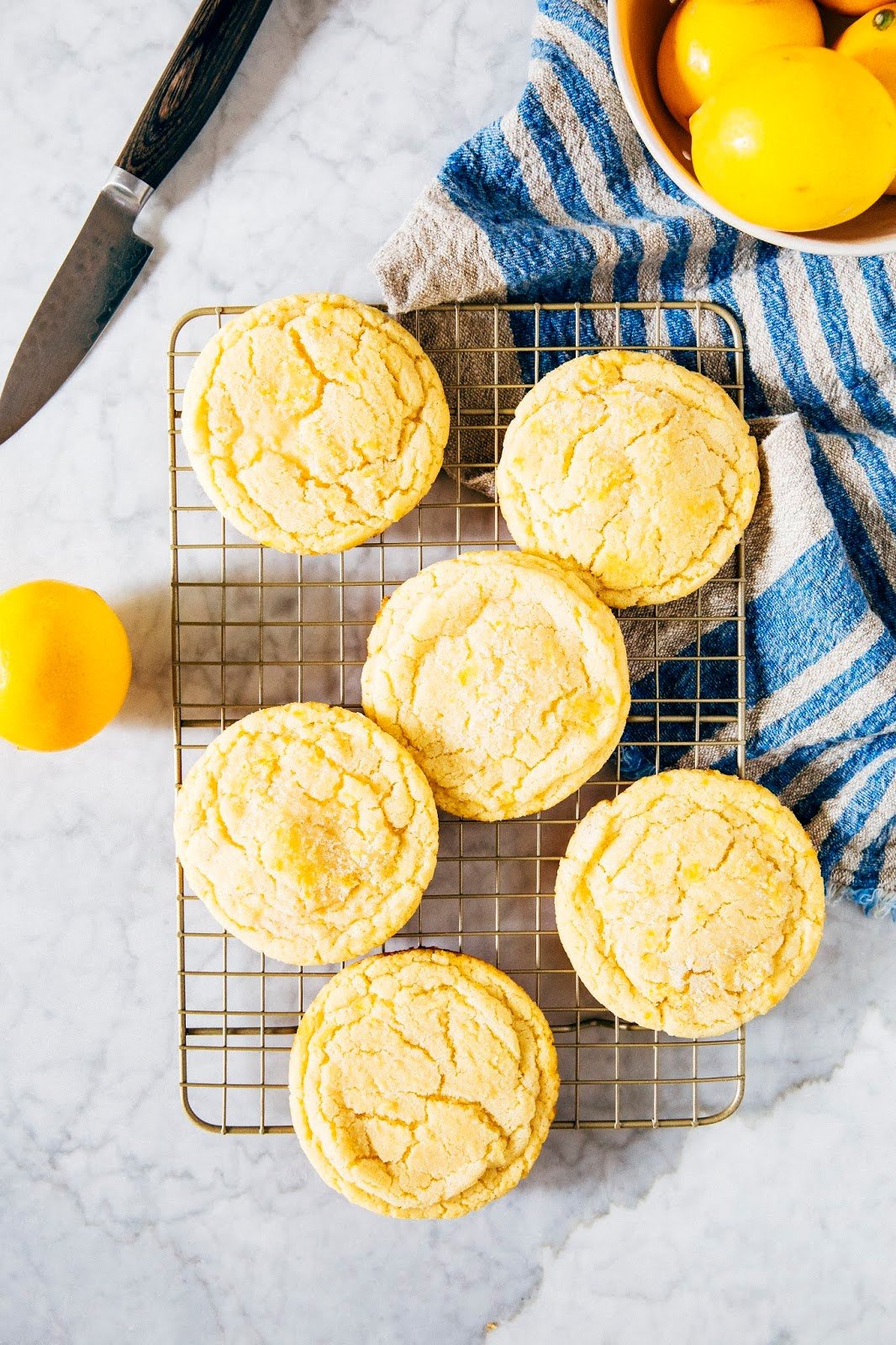
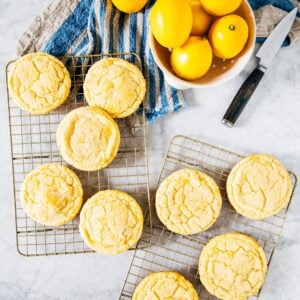

I have not made the cookies yet, but I will! I want to know where I can purchase the blue striped linen kitchen towel in the photo with the lemons/lemon cookies. Thank you in advance!
Sadly, I’m not really sure! It was a gift from a friend :/
These turned out great!
Conserving the precious AP flour, I halved this recipe.
I used a 1 TB cookie scoop. Smaller cookies, so only needed 9 mins in the oven. But the greater surface area meant that I needed the full amount of sugar topping (so don’t 1/2 that part!)
It made 2 dozen cookies.
I have made these several times now! I’ve also swapped out the Meyer lemons for key limes and for grapefruit! My husband said he liked the grapefruit ones the best, but that he would have devoured the entire plate of lemon ones if he had been given the chance. Ha!
Thanks so much for another hit 🙂
Hi there! I’m doing some research about using citric acid as a preservative in cookies and came across your recipe. Just curious as to whether you noticed any significant difference in the shelf-life of these compared to your normal snickerdoodle/lemon cookie? Still waiting for a few items before i start experimenting but thought i’d ask lol. Thank you for sharing your recipe!
Sadly, I don’t know! I gave a lot of these cookies away and we ate all the ones we kept in 1-2 days, lol.
omg yum! I made these tonight with bob’s red mill gluten free 1-for-1 baking flour (bc of celiac, not by choice!) and added a little bit of egg white. Crispy on the outside, chewy on the inside, perfect amount of sweet and sour! Thank you for your delicious creations!!
side note – I bought the huge bag of citric acid on amazon for this recipe. While I’m sure I will make these cookies on a regular basis, it’ll still take years to use it up. Turns out there are a TON of uses for citric acid (amazing hair conditioner) so the bag won’t go to waste!
Hi! Only have light brown sugar and no molasses- can ai just sub 1 for 1? And is there any way to use baking powder instead of the cream of tartar and how much? Sorry for all the Qs I just live in a high COVID place and want to avoid trips to the supermarket if possible!
Yes, you can just replace the brown sugar in the recipe with gran sugar. However, the cream of tartar sub won’t be an easy fix. I suggest taking a look at this recipe and using it as your base for these cookies instead: https://www.hummingbirdhigh.com/2020/12/snickerdoodle-recipe-without-cream-of-tartar.html
These were deliciousssss! We always make cookies that are chocolate chip or peanut butter and I was a bit bored so I looked on here and found this! It was great 👍
Most lemon cookie recipes always seem so bland, you can’t always taste the lemon. I thought these might be sour with the citric acid, but it really made a difference in the taste of the cookie. These are perfect!
I made this for a ladies Luncheon & they were a hit. Only thing I did different was: smaller cookies oh & I may have doubled the amount of zest & a small squeeze of the lemon I zested juice (barley a tblsp.) I also rolled the entire ball of dough in my zest sugar mix & had no problem with them sticking to parchment paper. Might have been because I only cooked them to where the sugar coating just began to brown & barley got a slight crisp on the outter edges. I made them w/ meyer lemon zest and also some w/ lime zest, some w/ sumatra mandrine orange zest & some w/ pink grapefruit zest. The lemon no doubt are the best, 2nd would be the lime, 3rd is the orange zest & use an actual naval oranges zest, mandrine zest didn’t work out very well, too much pyth going on.
I put one of each cookie onto a cookie paper oval (similar to size & shape of a milano cookie paper, if cookies were bigger I wouldve used a canoli paper to set 3 so three cookies lemon, lime & orange.
This year I bought some tiny white cookie boxes that have a top view window & my cookies are very close to the size of a macron & they’ll hold 3 of my citrus flavored cookies in each just right. I like to put out only individual deserts rather than a cake or a pie or something you’d have to spoon onto your plate. Which seems to have a more personable touch. Another desert I make for tji event are individual miniature cherry cheesecake bites in mini cupcake paper spiraled on a large platter I thought about putting each cheesecake into a fully enclose clear cupcake keeper., still need to price them & I just might. The cheesecakes a simple just 1 nilla wafer cookie on the bottom, then a dollip of whipped Philly creme cheese which I whip in the stand mixer & with granulated sugar and a squeeze of lemon juice & a drop or two of vanilla extract. You only need to mess with the consistency of the creme cheese using the lemon juice. Then I bake for 20 mins at 350 , then wait until they cool completely and top off each one with a couple of cherries (pie filling cherries in the can) I use ‘comstock’ all they need is 2 or 3 cherries each along w/ the cherry filling juice while spooning out cherries. Cover and refrigerate overnight to be sure they set nicely & can be picked up with your fingers without falling apart & just pop it into your mouth & finish off by licking anything thats on the paper, because they’re that good, you won’t want to waist a drop.
I don’t think I’ve seen anyone eat just one.
I need to mention I make these in my mini cupcake pans rather than a full size cupcake pan. They’re daintier and you’ll definitely eat more than one. Regular size cupcake pans take two nilly wafers and look sloppy to me, the mini cheesecakes look more uniform and set up faster plus hold together better. Bigger ones tend to fall apart when picking em’ up. Bigger sized ones can be eaten with a fork if you want to go that route.
Thanks have fun bakers!!!!